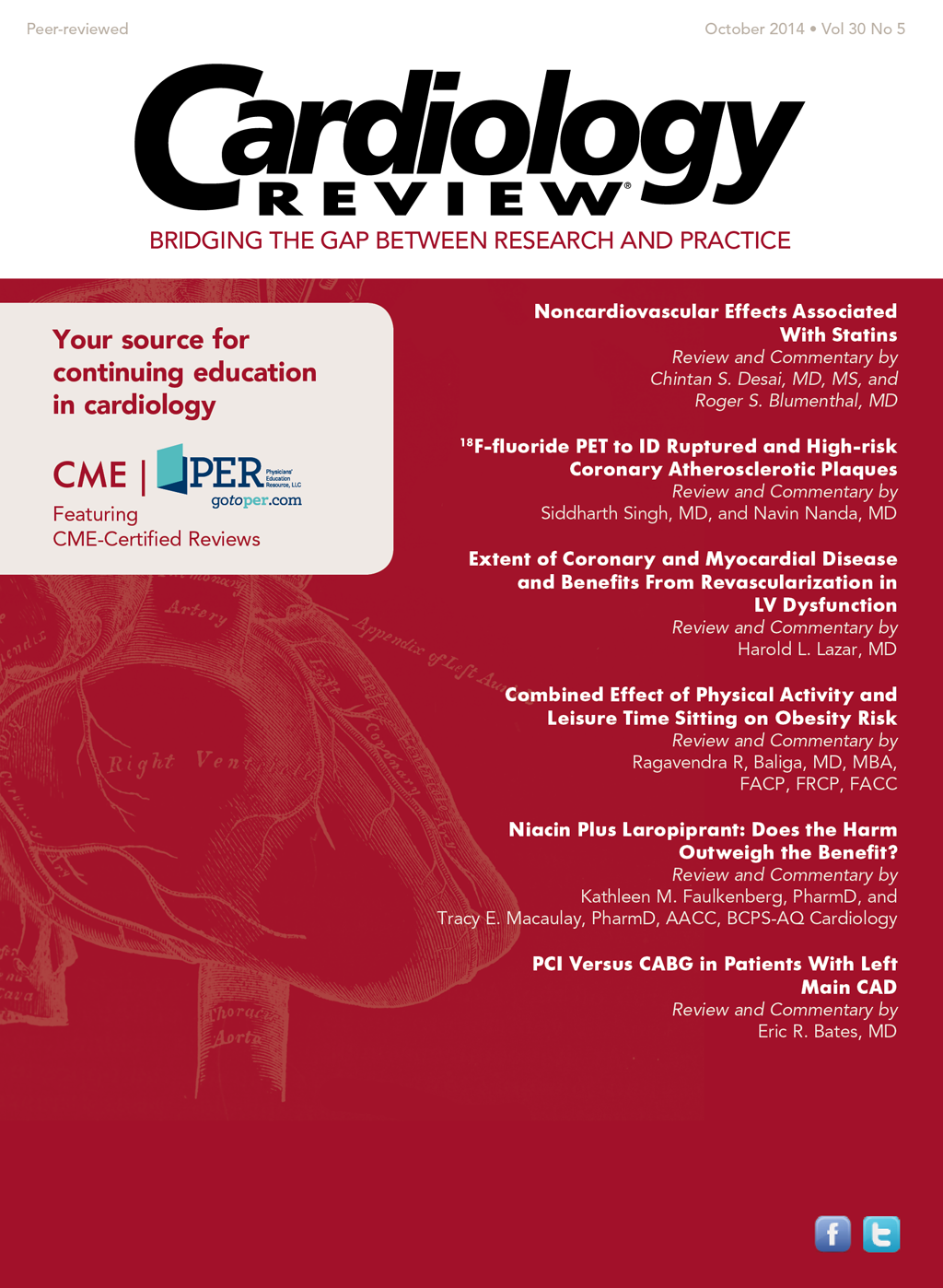Publication
Article
Cardiology Review® Online
F-fluoride PET to ID Ruptured and High-risk Coronary Atherosclerotic Plaques
Author(s):
The optimal duration of DAPT following PCI with drug-eluting stents remains dubious.
Review
Joshi NV, Vesey AT, Williams MC, et al.
18
F-fluoride positron emission tomography for identification of ruptured and high-risk coronary atherosclerotic plaques: a prospective clinical trial. Lancet. 2014;383:705-713.
C
oronary atherosclerotic plaque rupture is the leading cause of myocardial infarction (MI). Histopathologic characteristics noted in plaques at risk for rupture include positive remodeling, microcalcification, and large necrotic cores. At present, plaque rupture is primarily diagnosed using coronary angiography and invasive techniques.
Study Design
Using molecular imaging with positron emission tomography (PET) combined with computed tomography (CT), Joshi et al evaluated imaging characteristics of ruptured and high-risk atherosclerotic plaques in patients with MI, angina pectoris, and symptomatic carotid disease.
1
Radionuclide tracers used included
18
F-sodium fluoride (
18
F-NaF), which is considered an indicator of active microcalcification in plaques, and
18
F-fluorodeoxyglucose (
18
F-FDG), which reflects macrophage glucose metabolism. Using intravascular ultrasound (IVUS), the investigators also examined imaging characteristics of plaques with
18
F-NaF uptake in patients with chronic stable angina.
Patients were recruited from the Royal Infirmary of Edinburgh between February 2012 and January 2013. The study included 40 patients with MI, 40 with chronic stable angina, and 12 symptomatic patients who underwent carotid endarterectomy. Patients aged <50 years, patients with insulin-dependent diabetes (glucose competes with
18
F-FDG for uptake), patients with severe renal failure, and pregnant patients were excluded from the study.
Patients underwent
18
F-NaF and
18
F-FDG PET-CT, CT coronary angiography, and CT calcium scoring. Maximum standard uptake value of
18
F-NaF (the decay-corrected tissue concentration of the tracer divided by the injected dose per body weight) was measured and corrected for blood pool activity in the superior vena cava to provide tissue-to-background ratio (TBR). Plaques with TBRs >25% higher than a proximal reference lesion were classified as
18
F-NaF-positive lesions. The authors compared TBR value in culprit plaque with the highest value in nonculprit vessels. Quantification of
18
F-FDG was also performed in proximal and middle coronary arteries in areas where myocardial uptake was not significant.
Furthermore, the authors also evaluated characteristics of “vulnerable” plaques in patients with chronic stable angina. PET-CT imaging was used to direct IVUS imaging of PET-positive and -negative plaques. The interventional cardiologist performing IVUS examinations was blinded to the PET status of the plaque. Plaque area, composition (dense calcium, necrotic core, fibro-fatty tissue, and fibrous tissue), presence of plaque microcalcification, and remodeling index were evaluated. Plaques were classified as thin-cap fibroatheroma, thick-cap fibroatheroma, pathological intimal thickening, or fibrocalcific plaque. A blinded investigator also evaluated plaque composition, stenosis characteristics, and high-risk CT characteristics in PET-positive and -negative lesions.
The investigators also retrieved intact atherosclerotic plaques from carotid endarterectomy specimens, and performed ex-vivo PET-CT and histopathological analysis to correlate
18
F-NaF activity with plaque characteristics. Nine of 12 patients had evaluable specimens.
Ninety-two percent of enrolled participants were men. Patients underwent
18
F-NaF scans a median of 6 days after their MI. In 37 of 40 patients with MI, increased activity was noted in the culprit plaques.
18
F-NaF activity in the culprit lesion was 34% higher than the maximum activity recorded anywhere else in the coronary vasculature (maximum TBR, 1.66 [1.40-2.25] vs 1.24 [1.06-1.38], P <.0001). In 55% of patients coronary
18
F-FDG uptake could not be distinguished from myocardial uptake. In the remainder in which coronary
18
F-FDG could be distinguished from myocardial uptake, no significant differences were noted between culprit and nonculprit plaques.
Among endarterectomy specimens (n = 9),
18
F-NaF uptake was noted to localize to areas of macroscopic plaque rupture.
18
F-NaF testing was performed a median of 17 days after surgical excision. Sections with increased
18
F-NaF uptake showed increased indicators of calcification, cell death, and macrophage infiltration on histopathologic evaluation.
In patients with chronic angina, focal
18
F-NaF uptake was noted in 18 patients (45%), and this was not related to percutaneous coronary intervention. Maximum TBR for
18
F-NaF-positive plaques was 1.90 (interquartile range [IQR], 1.61-2.17) and for
18
F-NaF-negative plaques was 1.02 (0.82-1.17). Plaques with
18
F-NaF activity had more adverse remodeling, microcalcification, and larger necrotic cores on IVUS imaging. Predefined suppression of myocardial
18
F-FDG uptake occurred in 34 (85%) of patients. However, increased focal
18
F-FDG uptake was noted only in 4 vessels (3 at site of recent stenting).
The authors concluded that
18
F-NaF uptake localizes to regions with plaque rupture and associated microcalcification, cell death, and inflammation in patients with MI and symptomatic carotid artery disease. Moreover, in patients with stable chronic angina,
18
F-NaF uptake identified coronary plaques with high-risk features on IVUS.
18
F-FDG imaging had limited utility for imaging ruptured plaques and those at risk of rupture.






